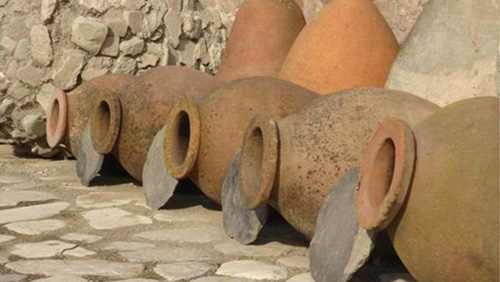
by Marco Giovanetti
Georgia is one of the oldest winemaking nations in the world, and by some experts even considered as the birth-place of wine. This fact is known by 8000 years old archeological findings of grape-pips inside antique clay pots. Wine is one of Georgia’s main cultural heritages, and has always been playing an important role in celebrations and rituals, both in pre-Christian and Christian time.
In Georgia the conditions are well suited for winemaking, as the climate is moderate and extreme weather conditions are rare. The summers are not too hot and the winters are mild. Also, the surrounding mountains are full of natural springs, with rivers providing mineral rich waters into the valleys.
Wine is a main sacred symbol in the Georgian Orthodox Church. Christian architectural monuments, icons and frescos do often include wine themes. As for other Christian traditions, also in Georgia wine and bread is the symbol of the blood and flesh of Christ. In the Georgian Orthodox tradition however, this does not apply only for communion and other Christian ceremonies. For Georgians wine is truly synonymous with the blood of Christ in all situations, and Georgians with respect for their culture and tradition will always treat the wine with honor and dedication.
Georgia is especially renowned for an ancient form of winemaking that uses qvevris, clay “jars” (some hold up to 9,000 litres) lined with beeswax, filled with crushed grapes and juice, and then buried in the ground — originally done, some speculate, to control temperatures and to protect the wine from invaders.
These days, many smaller wineries are still using the traditional ways and grapes; the country boasts more than 500 indigenous varieties, many of which are being researched and documented at the National Centre for Grapevine and Fruit Tree Planting Material Propagation in Saguramo.
Today the Georgian winemaking is concentrated on dry and semisweet table wines. Winemaking is generally concentrated in three regions: Kakheti, Kartli and Imereti, where Kakheti alone contributes to approximately 60-70% of the total production. Cognac and champagne are prepared in Kartli, while brandy as well as 80 percent of Georgia’s sparkling wine is produced in Imereti. High-quality semisweet wines are mainly produced in the Racha-Lechkhumi region.
Main Grapes in Georgia
While Georgians claim more than 500 indigenous grape varieties, only a handful are known outside of the country. Here are four that can be found in the Canadian market:
Rkatsiteli — A popular, food-friendly white primarily used in Georgias Kakheti region.
Kisi — A white variety that can make delicate and beautifully aromatic wines.
Saperavi — A red grape that makes rich, lush wines, which can be dry or semi-dry. Wines show great potential for aging.
Mtsvane Kakhuri — A popular white variety.
What do Georgian wine taste alike
In a recent tasting organized by Cyril Kérébel of La QV, I had the chance of taste a number of Georgian wines. Their taste was like nothing that I have encountered before. Their range of flavors and smells remind very much of the gastronomy of middle eastern countries such as Iran, Algeria and Turkey. In fact many of the wines will match wonderfully with these types of cuisines. In Quebec, most Georgian wines are imported privately. If you want to try some of the wines described below ( which I highly suggest you do!!!). You will have to contact, La QV. Now the wines...
Tasting Notes:
Kakheti 2011, Mtsvane, Pheasant’s Tears ( $31.00. La QV, 6 bottles/case)
Very perfumed nose. Honey, Wax, Pistachios and Baklava come to mind. In addition some animal nuances and dry apricots. In the mouth, medium body with a wonderful balance and texture and concentration. Retronasal reminding me of apricot jam. Very long and savoury wine. 96\100.
Mukhrani 2011, Chinury, Iagos Wine ( $35.20. La QV, 6 bottles\case)
On the nose, white flowers, vanilla, peaches. In the mouth, the wine is medium body. Dry with a good acidity. Elusive, it reminds me of rain water with a mineral infusion of copper and sulphur. Very fine and delicate. 92\100.
Kakheti 2011, Rkatsiteli, Pheasant’s Tears ( $28.50, La QV, 6 bottles/case)
On the nose, dry apricots, peach jam. In addition, honey and and nuts. In the mouth,medium body. Very refreshing with a good acidity. Good tannic feeling despite being a white wine. 92\100.
Kakheti 2011, Rkatsiteli, Teleda ( $30.50, La QV, 6 bottles/case)
Very complex. Mind blowing aromas that remind me of anise, smoke and honey. In addition, shortbread biscuits with full of apricots flavours. Medium to full body. Nice rich mouthfeel. Very expansive. Good finale. 90\100.
Kakheti 2010, Rkatsiteli, Alaverdi ( $40.00, La QV, 6 bottle/case)
On the nose, aromas that remind me of cherry, nail polish and fresh paint. Actually, the whole bouquet remind me of an oloroso sherry. In the mouth, very lactic. Very good wine but an acquired taste. 87\100.
Kakheti 2011, Saperavi, Pheasant’s Tears ( $29.75, La QV, 6 bottle/case)
Animal notes with bell pepper with a bit of dry fruits such as figs and dates, maple syrup. In the mouth, rich, dense and tannic. Earthy with hints of brett. 93\100
Karti 2011, Tavkeri, Pheasant’s Tears ( $28.50 La QV, 6 bottles/cases)
Aromas that remind me of black fruits, smoke and lots of seaweed( yes!!!) and lactic smells ( cheese). In the mouth, rustic with animal notes and very earthy. Amazing wine. 95\100.
© mtltimes.ca






